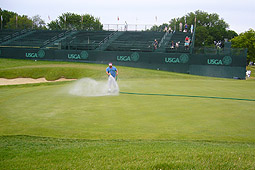On The Road With The USGA - July 2008
Turf water management is an agronomic building block upon which health and playability reside. Too wet opens the door to disease, physiological decline, and poor playability. Too dry can also result in disease, plant health decline, and compromised playability. When doubt arises it is always better to miss on the dry side as the negatives are more intense on the wet end of the continuum, and it is much easier to add water than to remove an excess. Getting it right, so to speak, is not always easy, but it is worth the effort. Recognizing that a big part of preparing a golf course for play is water management, intensity is elevated when preparing for and taking a course through a big event. This clearly applies to the recently concluded U.S.Women's Open Championship in Edina, Minnesota.
 |
The USGA TruFirm device is an excellent tool for zeroing in on the amount and frequency of water needed. It actually serves to quantify what is being applied so that adjustments can be made without compromising turf health. Nonetheless, as with golf turf management as a whole, there is both a science and art to water management. In addition, aeration and topdressing, which directly impact the physical attributes of the root zone structure, are part of the water management building block/equation (water management = drainage/aeration + irrigation/rainfall). Further, fertilization merges with aeration pore space in the soil to accommodate good rooting, which in turn, influences watering - it's much easier to be conservative with watering when there is deep rooting as compared to what shallow roots mandate. Mowing (type of mower and the actual cutting height) and the grass-growing microenvironment (sunlight and air movement) also must be factored into good water management.
The bottom line message is that quality golf turf management hinges on water management. Most golf courses have room to at least tweak the pursuit of firmer and drier surfaces and the time and money so invested will improve turf health, playability and dependability.
Call or e-mail anytime - we're always available.
Source: Bob Brame, bobbrame@usga.org or 859-356-3272
